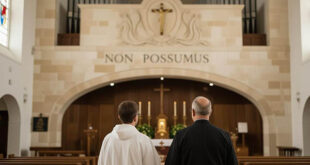The afterlife has always been a central theme in the Christian faith and throughout human history. From the times of the Old Testament, Sacred Scripture speaks of a place where souls go after death, called Sheol in Hebrew and Hades in Greek. But what exactly does this concept mean? How did the Jews understand it before Christ? And what does Christian revelation teach us about this mystery?
In this article, we will explore in depth the reality of Sheol and Hades according to the Bible and Christian tradition. We will also see how this teaching remains relevant to our spiritual life today.
1. What Is Sheol in the Old Testament?
In the Hebrew mindset, Sheol is the place of the dead. It is not exactly heaven or hell, but rather a shadowy dwelling where all souls go after death, both the just and the unjust. In the Old Testament, it is described as a place of darkness and silence:
“For in death there is no remembrance of You; in Sheol, who will give You thanks?” (Psalm 6:5)
Sheol is, in a sense, a kind of “shadow” of human existence—a place of waiting where the dead have no contact with the living and cannot actively praise God. However, it is not a final condemnation but rather an intermediate state.
2. Hades in Greek Tradition and Its Use in the New Testament
When the Old Testament was translated into Greek in the Septuagint (known as the LXX), the Hebrew word Sheol was translated as Hades, a term borrowed from Greek mythology. However, in the biblical context, Hades does not refer to a pagan realm of gods and punishments but to the same Hebrew concept of Sheol—the dwelling place of the dead.
In the New Testament, Jesus and the apostles use the term Hades to refer to this place of waiting. For example, in the parable of the rich man and Lazarus (Luke 16:19-31), Jesus describes how the rich man goes to Hades in torment, while Lazarus is carried to “Abraham’s bosom,” a place of comfort within the same realm of the dead.
“And in Hades, being in torment, he lifted up his eyes and saw Abraham far off and Lazarus at his side.” (Luke 16:23)
This parable reveals an important distinction within the underworld: it is not a single, undifferentiated fate, but rather a divided realm where the just and the condemned experience different realities.
3. What Happened to Hades and Sheol After Christ’s Death?
One of the most mysterious and profound moments of the Christian faith is Christ’s descent into Hades, which we proclaim in the Creed: “He descended into hell.” But what does this mean?
After His death on the cross, Christ descended into Sheol to free the just who had been waiting for redemption. This was not a moment of suffering for Him but an act of victory: Jesus conquered death and opened the gates of heaven.
Saint Peter expresses it this way:
“For Christ also suffered once for sins, the righteous for the unrighteous, to bring you to God. He was put to death in the body but made alive in the Spirit. In that state, He also went and made proclamation to the spirits in prison.” (1 Peter 3:18-19)
With Christ’s resurrection, Sheol lost its original function. From that moment on, the souls of the righteous no longer descend to that place of waiting but enter directly into the glory of heaven.
4. Theological Relevance and Application in the Christian Life
a) Sheol Reminds Us of the Reality of Death and Our Hope in Christ
The concept of Sheol and Hades teaches us that death is not the end but a transition. For the ancient Jews, it was a place of waiting; for us, it is the door to eternal life with God. This invites us to live with an eternal perspective, placing our trust in Christ, who has conquered death.
b) Christ’s Descent into Hades Assures Us of God’s Mercy
The fact that Jesus descended into Sheol means that there is no place beyond the reach of God’s grace. Even in death, Christ brought salvation. This comforts us when we remember our deceased loved ones—we know that God’s mercy is greater than any human destiny.
c) A Call to Live with Wisdom and Vigilance
The teaching about Sheol and Hades also calls us to take our spiritual life seriously. Jesus made it clear in the parable of the rich man and Lazarus that our present life has eternal consequences. It is not enough to avoid evil; we must actively seek holiness, charity, and justice.
“Watch therefore, for you know neither the day nor the hour.” (Matthew 25:13)
5. Conclusion: Sheol Has Been Conquered by Christ
The mystery of Sheol and Hades reveals the deep history of salvation. Before Christ, it was a place of waiting; after His victory on the cross, it became a testimony of redemption.
Today, this teaching invites us to live with hope and responsibility, knowing that our earthly life is only the beginning of an eternal existence in God. It encourages us to trust in Christ’s mercy and to live each day prepared for our ultimate encounter with Him.
May this reflection help us to see our lives with the eyes of eternity, placing our trust in the One who conquered death and opened the gates of heaven.
How Can You Apply This Teaching in Your Life?
- Meditate on the reality of death, not with fear, but with hope in the resurrection.
- Live each day with the awareness that our actions have eternal consequences.
- Trust in God’s mercy and pray for the souls of the departed.
- Strengthen your faith in Christ’s resurrection and His promise of eternal life.






